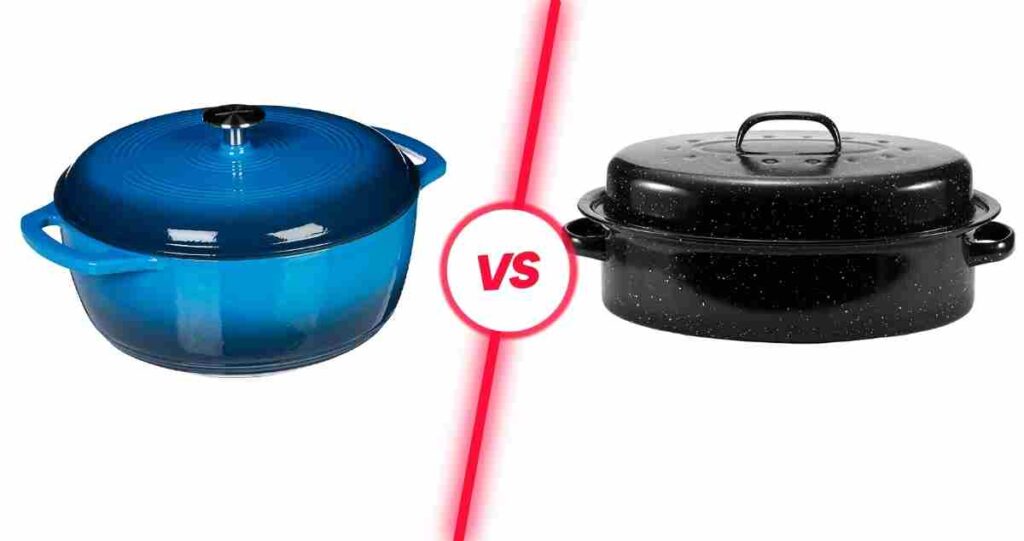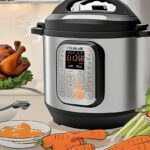There’s something magical about a kitchen well-stocked with the right tools. Whether you’re a seasoned chef or just getting the hang of boiling water, you’ve probably encountered the ongoing debate: Dutch oven vs. roasting pan. Both are timeless stalwarts in any cooking arsenal, and each brings its unique personality (pun intended).
This post will pit these two cooking powerhouses against each other in a friendly culinary showdown. By the end, you’ll have a solid understanding of what makes a Dutch oven and a roasting pan distinctive, and perhaps even decide which one deserves that coveted spot in your kitchen.
So, grab your aprons, roll up your sleeves, and dive into the simmering debate of Dutch oven vs. roasting pan. Let the food fight begin!
Comparison Chart:
| Feature | Dutch Oven | Roasting Pan |
|---|---|---|
| Material | Usually cast iron, but also comes in ceramic and enamelled cast iron | Usually stainless steel, but can also be made from aluminum, hard-anodized aluminum, or enameled steel |
| Lid | Comes with a tight-fitting lid | Typically lid-less, though some models come with a lid |
| Shape | Round or oval, deep | Rectangular, shallow and wide |
| Stove Compatibility | Compatible with all stovetops and ovens | Generally oven-safe, some are also stovetop safe |
| Heat Distribution & Retention | Excellent due to the material, good for slow and long cooking | Good, best for cooking at high temperatures for shorter periods |
| Versatility | Very versatile; can be used for baking, frying, sautéing, roasting, and braising | Primarily used for roasting and baking, but can also be used for broiling |
| Maintenance & Care | Requires regular seasoning if not enameled, should not be washed with soap | Generally dishwasher safe, easier to clean |
| Price | Tends to be more expensive | Usually less expensive, depending on the material and brand the difference? |
5 major differences between a Dutch oven and a roasting pan:
Sure thing, let’s dive into the nitty-gritty of our kitchen heavyweights – the Dutch oven and the roasting pan.
- Structure and Material: You’ll first notice that a Dutch oven is a thick-walled pot with a tight-fitting lid, typically made of cast iron. It’s built like a tank and retains heat like a champ. In contrast, a roasting pan is a large, shallow dish, usually made from stainless steel or hard anodized aluminum. It’s perfect for browning and crisping but isn’t going to hold onto heat as well as the Dutch oven.
- Heat Source Compatibility: Dutch ovens are versatile, can be used on the stovetop or in the oven, and they’re even game for outdoor cooking on a campfire. Roasting pans, on the other hand, are mostly confined to the oven. They’re perfect for big roasts and turkeys but don’t think about trying to whip up a stovetop stir-fry in one.
- Cooking Methods: The Dutch oven is a master of slow, even cooking. It’s your go-to for soups, stews, braises, and anything that needs to simmer for hours. The roasting pan, however, shines when you’ve got a big piece of meat that needs to be cooked evenly and browned to perfection – your Thanksgiving turkey, your Sunday roast, you name it.
- Moisture Retention: Thanks to its heavy lid, the Dutch oven excels in trapping moisture, which makes it ideal for recipes where you don’t want the food to dry out. In contrast, the open design of a roasting pan promotes evaporation and helps create a delicious, crispy crust on your food.
- Maintenance and Durability: Cast iron Dutch ovens require a bit of love and care – they must be seasoned, can’t be cleaned with soap, and must be dried thoroughly to prevent rust. But if you treat them right, they’ll last generations. Roasting pans are a bit more forgiving. Stainless steel versions can be cleaned easily, don’t require seasoning, and while they might get a few scrapes and dings, they’re less likely to break or become unusable.
Five major features, three advantages, and one disadvantage of the Dutch oven and roasting pan:
Dutch Oven
Product Description: Meet the culinary champion – the Dutch Oven. It’s a rugged, versatile cooking pot made from heavy-duty cast iron, with a snug-fitting lid that traps heat and moisture for delicious, tender meals every time.
This kitchen equipment is as durable as it is versatile and just as comfortable on the stovetop as in the oven or even out on the campfire.
Features:
- Heavy-Duty Construction: Made from cast iron, the Dutch oven retains heat for even and slow cooking.
- Snug-Fitting Lid: Designed to trap heat and moisture, ensuring your dishes remain juicy and flavorful.
- Versatile: Can be used on the stovetop, in the oven, or over a campfire. Perfect for a wide range of cooking methods.
- Durable: With proper care, a Dutch oven can last for generations. It’s an investment in your kitchen.
- Excellent Heat Distribution: The thick walls of a Dutch oven distribute heat evenly, reducing the chances of burning or uneven cooking.
Advantages:
- Versatility: From the Dutch oven has many culinary applications, from roasts to bread and desserts, the Dions.
- Excellent Heat Retention: The cast iron construction is perfect for slow-cooking dishes
- Long-Lasting: Properly cared for, a Dutch oven can become a family heirloom, passed down through generations.
Disadvantage:
- High Maintenance: Cast iron requires proper seasoning and careful cleaning to avoid rust and maintain its non-stick properties.
Roasting Pan
Product Description: Say hello to the ultimate tool for creating perfect roasts – the Roasting Pan. Typically made from stainless steel or hard anodized aluminum, this large, shallow dish is designed to cook large cuts of meat evenly and crisply. It’s a must-have for special occasions and big family gatherings.
Features:
- Large and Shallow: The roasting pan’s design allows maximum heat exposure, creating a beautiful, even browning on your roast.
- Durable Materials: Stainless steel or hard anodized aluminum construction makes this pan sturdy and long-lasting.
- Rack Included: Many roasting pans come with a rack, allowing heat to circulate underneath the food for even cooking.
- Easy to Clean: Unlike cast iron, most roasting pans are dishwasher-safe and don’t require special care.
- Oven-Safe: Perfect for oven roasting, whether it’s your Thanksgiving turkey or a weekend roast beef.
Advantages:
- Perfect for Large Roasts: Its size and shape make the roasting pan perfect for cooking large cuts of meat.
- Easy Maintenance: No need for special cleaners or seasoning – most roasting pans can even go in the dishwasher.
- Even Browning: The pan’s design allows for even heat distribution, which leads to beautiful browning and crisping.
Disadvantage:
- Not Versatile: The roasting pan is perfect for its job but isn’t suited to other cooking methods.
Similarities:
Absolutely, despite their differences, the Dutch oven and roasting pan share several noteworthy similarities:
- Versatile Kitchen Tools: Both are essential kitchenware items that offer a broad range of culinary possibilities. Both tools can help you create a wide array of delicious dishes, from slow-cooked meats to delightful baked goods.
- Excellent Heat Conductors: These materials are excellent heat conductors, whether cast iron (Dutch oven) or stainless steel/hard anodized aluminum (roasting pan). This ensures that your food cooks evenly and thoroughly, reducing the chances of hot spots or undercooked portions.
- Durable Construction: Dutch ovens and roasting pans are both built to last. They can withstand high heat and are resistant to wear and tear. With proper care, these kitchen workhorses can serve you for generations.
- Oven Safe: Dutch ovens and roasting pans are designed to be used in the oven, making them ideal for dishes that need long, slow cooking times or for finishing off a dish seared on the stovetop.
- Capable of Large Meals: Whether it’s a hearty stew in a Dutch oven or a holiday roast in a roasting pan, both tools are designed to handle larger meals, making them perfect for family gatherings or meal prepping.
Which is better, the Dutch oven or the roasting pan?
Determining which is better, a Dutch oven or a roasting pan, depends on your specific cooking needs and preferences. Here are some factors to consider when making your decision:
- Cooking Style and Recipes:
A Dutch oven is an excellent choice if you frequently cook soups, stews, braises, and dishes that require slow, even heat. Its versatility, heat retention, and ability to trap moisture make it ideal for these recipes. On the other hand, if you often prepare large roasts, whole poultry, or dishes that require browning and crisping, a roasting pan would be more suitable.
- Versatility:
Dutch ovens are known for their versatility. They can be used on the stovetop, in the oven, and even over an open flame, making them great for indoor and outdoor cooking. While primarily designed for roasting in the oven, roasting pans may have limited versatility beyond this specific cooking method.
- Maintenance:
Dutch ovens, especially those made of cast iron, require specific care, such as seasoning and avoiding the use of soap, to maintain their non-stick properties and prevent rust. Roasting pans, typically made of stainless steel or hard anodized aluminum, are generally easier to clean and maintain.
- Cooking Capacity:
Dutch ovens are available in various sizes, accommodating different quantities of food. Roasting pans are typically larger and shallower, specifically designed to accommodate larger cuts of meat or whole birds. They are suitable for both small and large-scale cooking.
- Cost:
Dutch ovens, especially high-quality ones, can be more expensive due to the materials used and their versatility. Depending on the material and brand, roasting pans can offer a more affordable option.
Ultimately, the “better” choice between a Dutch oven and a roasting pan depends on your cooking preferences, the dishes you often prepare, and your budget. Some cooks may find value in owning both, as they serve different purposes in the kitchen.
 Conclusion:
Conclusion:
In the sizzling showdown between the Dutch oven and the roasting pan, it’s clear that both kitchen heavyweights have their own strengths and unique attributes. With its cast iron construction and exceptional heat retention, the Dutch oven shines in slow-cooked dishes and versatile cooking methods.
On the other hand, with its spacious design and ability to create a delectable crispy crust, the roasting pan is a go-to for roasts and achieving that perfect golden brown.
Ultimately, choosing between these culinary champions comes down to your cooking style, favorite recipes, and desired outcomes. Whichever you choose, the Dutch oven and roasting pan will elevate your cooking game and bring countless delicious meals to your table.
Consider your needs, explore your culinary ambitions, and embrace the tool that best suits your kitchen adventures.
- What size pan is one and a half (1.5) quarts? - June 8, 2023
- Le Creuset saucepan sizes: Choosing the Perfect Pan - June 8, 2023
- Blue diamond pan instructions: Step-by-Step Guide - June 8, 2023






